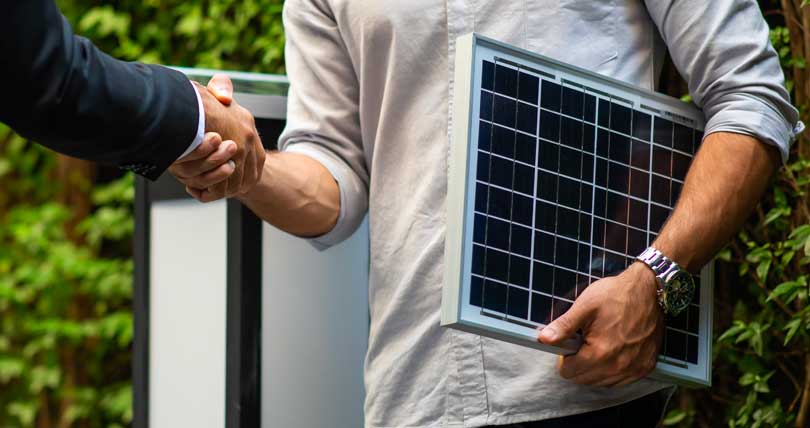As we enter the fall season, we want to congratulate all of our Solar Club microgenerators and welcome new members. It has been a great year for Solar Club members, and 2023 promises to be even better.
Today, roughly one out of every four Alberta microgenerators are being provided service through the Solar Club’s network of retailers.
Before we look ahead to next year, we’d like to give new members a little background on the significance and importance we place on the role of microgenerators.
The Solar Club was introduced by Green Alberta Energy (a division of UTILITYnet) in 2015. We adopted the tenacity of the hummingbird, “Do what you can, and never give up.” This mindset was captured in a story you will find on the Green Alberta Energy website. I hope you’ll take a moment to explore our website and see why we’re invested in greening the grid.

2022 has been a good year. Over the last 12 months, we paid almost $4 million to microgenerators for the surplus electricity they exported to the grid. Over the last decade (and by the end of 2022), Solar Club members will have exported nearly 50 million kWh of green electricity onto the grid. Furthermore, Green Alberta Energy has purchased 55 million kWh of equivalent biomass Renewable Energy Certificates (RECs), much of which has been gifted to microgenerators as an added benefit of being Solar Club members. Together, we have positively impacted the environment by making the grid greener every day. Just like the hummingbird – every little bit helps.
We encourage all consumers to participate in greening their consumption, even if they don’t have solar panels on their homes. It’s affordable and flexible. Did you know the average homeowner could green 30% of the electricity they consume for only 10 cents per day? Reducing one’s carbon footprint does not have to be expensive and is voluntary. For those not interested in putting solar panels on their roof, consider buying RECs. Green what you can afford.
The Alberta energy market is turbulent today. The closure of coal plants, constraints in the natural gas market, the federal carbon tax, and lower production from wind generators during hot summer months contributed to the cost of power supplied by Alberta’s fleet of generators reaching unprecedented highs. In Alberta today, the tie-lines between BC/Montana and Alberta are down for maintenance. This resulted in several energy alerts announced by AESO in September.
In October, the majority of the 40% of consumers still on the Regulated Rate Option (RRO) will pay over 18 cents per kWh – the highest regulated price ever charged for electricity in Alberta. Those who invested and added solar panels to their homes have avoided these skyrocketing prices.
Not everything in life and our business is “what’s in it for me.” We take our social and community responsibilities seriously. Membership in the Solar Club is free and open to all microgenerators in the province. We only ask new members to make a voluntary donation to a local food bank or charity of their choice and lend a helping hand to those in need. Collectively, the retailers in our network donate to local community partners on a regular basis. We contribute to the following causes and organizations by drawing on the income earned from the sale of electricity, natural gas, and internet services. This is a partial list of the various groups we are proud to help and support with financial contributions.
Airdrie & District Community Foundation • Ardrossan Dreamcatcher Nature Assisted Therapy Association • Battle River Watershed Alliance • Bawlf Educational Support Team Foundation • Boys and Girls Club of Strathcona County • Burdett Community Cemetery Committee • Calgary Library Foundation • Camrose Women’s Shelter • Canadian Mental Health Association Camrose • Canadian Parks And Wilderness Society ( CPAWS ) • Cochrane & Area Humane Society • Cochrane & Area Victim Services • Cochrane Food Bank • Drumheller Humane Society • Festival Place Cultural Arts Foundation • Foundation for Gender Variant and Sexual Minorities • Fort City Church • Fort McMurray Boys and Girls Club • Habitat For Humanity Camrose • Kids Cancer Care Foundation of Alberta • King’s Kids Promotions Outreach Ministries Incorporated • McMurray Gospel Assembly • Muscular Dystrophy Canada • Open Door • Parents Empowering Parents Society • Rocky View High Schools • Ronald McDonald House • Saffron Centre – Sexual Violence Support • Spinal Cord Injury Alberta
In 2012, when we started the Solar Club, only a few homeowners in Alberta had solar panels on their rooftops. Today there are over 9,000, and that number is growing. If government policies and regulations are enhanced, the province can easily double and triple the footprint of solar PV installations on homes and farms in the agricultural community. This is especially true today as the country works toward its Net-Zero goals by 2035. Given the current energy shortage in Alberta, now is the right time to encourage owners of microgeneration systems to increase production and shipments of carbon-free electricity onto the grid.
The bottom line is that the growth of the microgeneration industry should not be dependent upon government subsidies. We ask all microgenerators in the province to express support for Solar Alberta’s lobby efforts to amend the Alberta Microgeneration Regulation to enable unlimited energy exports.
This change would be in keeping with the recently passed Electricity Statutes (Modernizing Alberta’s Electricity Grid) Amendment Act, 2022, which enabled unlimited self-supply with export for larger industrial companies. Unfortunately, microgenerators’ ability to supply electricity from their solar PV systems is limited in what they can export to the grid, as the number of panels allowed is determined by the owner’s annual electricity consumption.
Restricting home and farm owners’ panel allowances is counterproductive to the goal of trying to lower our carbon footprint and increase the supply of renewable energy.
The language of the regulation currently serves as a cap on the size of an installation; it results in only a portion of roofs or properties being covered with solar, rather than maximizing energy generation potential. This regulatory cap means we are missing a significant opportunity to reduce carbon emissions. It also means that only big solar farm operators and industries can use energy production as an income-generating activity, and not everyday Albertans.
The limit was established by former Premier Stelmach and then Minister of Energy, Mel Knight. Times have changed. If the government wants to advocate for clean energy solutions – this is a no-cost policy and a zero-subsidy recommendation that can be implemented immediately. Don’t wait.
Darren Chu
Green Alberta Energy
a division of Utility Network & Partners.




